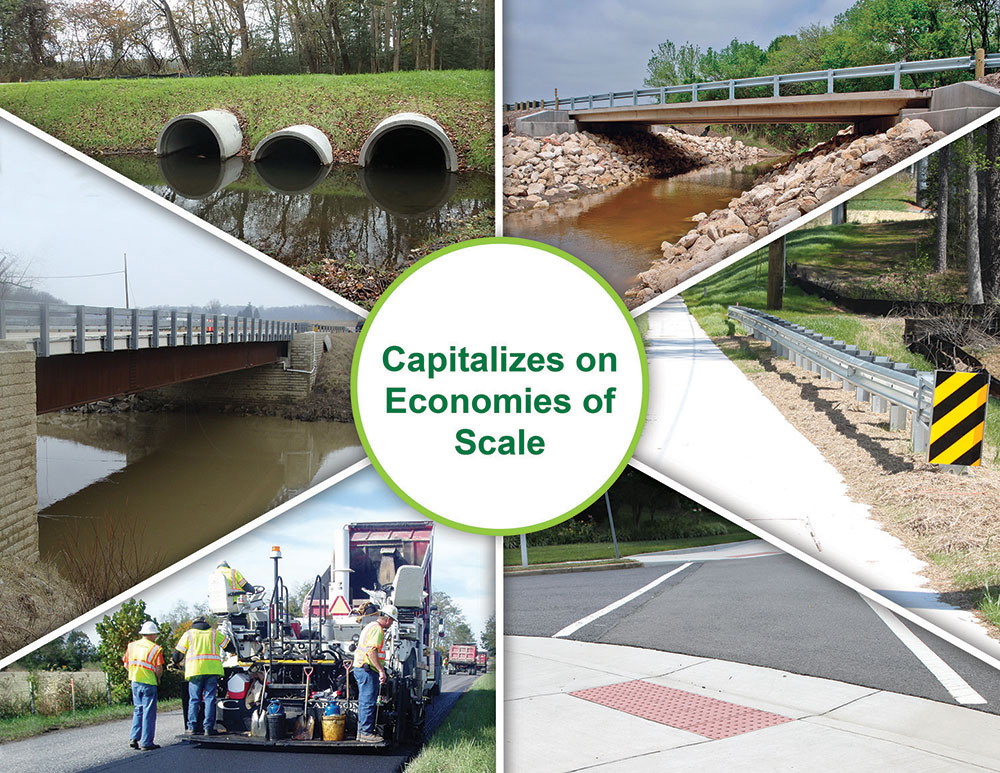April 11, 2019
Innovation of the Month:
Project Bundling
Last week, we introduced project bundling as our innovation of the month. This approach saves time, achieves economies of scale, and helps keep critical transportation assets in good repair by aggregating design or construction work in strategically combined contracts.
Using a stakeholder partnering approach, ODOT worked closely with the County Engineers Association of Ohio and municipalities to repair or replace more than 200 locally owned bridges in 3 years through its Ohio Bridge Partnership Program. ODOT developed bundles for design and construction of the bridges that accommodated both large and small contractors. To maximize efficiency, most projects were completed using detours with simple construction techniques and minimal approach road work.
ODOT funded the program through $120 million in Federal Grant Anticipation Revenue Vehicle (GARVEE) bonds and toll credits, allowing most local agencies to have bridges improved at no cost to them.
Watch the EDC-5 project bundling orientation webinar to learn how agencies are bundling projects to save time and money.
If you would like more information on this program or need technical assistance, please contact Romeo Garcia of the Federal Highway Administration Office of Infrastructure or David Unkefer of the FHWA Resource Center.
National Work Zone Awareness Week
In recognition of National Work Zone Awareness Week, FHWA is encouraging states to use smarter work zone technologies and strategies.
The Work Zone ITS Implementation Tool is a software companion to the 2014 Work Zone Intelligent Transportation Systems (ITS) Implementation Guide, which presents a framework for assessing the suitability of ITS as part of an agency's work zone management program. The tool will assist agencies with independent decision-making regarding selection, design, procurement, deployment and evaluation of ITS systems for construction and maintenance projects.
If you'd like to arrange training on this tool for your team, please contact Jawad Paracha with the FHWA Work Zone Management Team for more information.
Colorado saves $14 million using 2-dimensional hydraulic models
Two-dimensional hydraulic analysis, used by 44 state DOTs, is finding new life in the data-rich environment of the post-2013 Flood zone, where Geographic Information System information and LiDAR data is abundant to the public.
Colorado DOT (CDOT) Region 4 saved more than $14 million using 2-dimensional hydraulic models during design analyses over the past three years. It successfully applied this technology to more than 30 percent of the 95 projects supported by the Hydraulics Unit to develop a more detailed and granular hydraulic analysis of bridges, culverts and roadways in Colorado waterways.
Now, CDOT is taking this experience statewide through an initiative to value-engineer CDOT projects at the planning and scoping stage of design construction to save $20 million annually. Building on previous successes, CDOT's 2-dimensional quick-check initiative is expected improve transportation safety, optimize public investments in infrastructure, and improve the ecological performance of large bridges and culverts on Colorado's highways by 2021.
To learn more about how 2-dimensional hydraulic modeling can bring savings to your agency, please contact Scott Hogan with FHWA's Resource Center.
About EDC
Every Day Counts, a State-based program of the Federal Highway Administration’s Center for Accelerating Innovation, works with State, local, and private sector partners to encourage the adoption of proven technologies and innovations to shorten and enhance project delivery.



